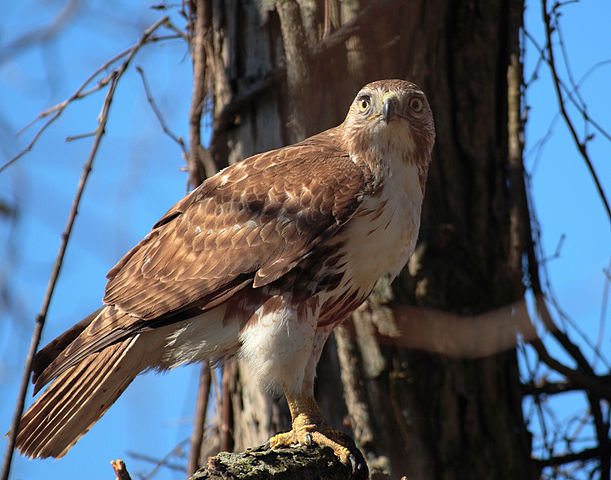Post by Eaglehawk on Jul 16, 2019 12:01:58 GMT
Southern Crested Caracara - Caracara plancus
The Southern Crested Caracara (Caracara plancus), also known as the Southern Caracara or Carancho, is a bird of prey in the family Falconidae. The classification of this species and name have evolved. It was formerly placed in the genus Polyborus. The use of the name formerly extended to two subspecies: the Northern Caracara (C. cheriway) of the southern United States, Mexico, Central America and northern South America, and the extinct Guadalupe Caracara (C. lutosa) as subspecies. As the name is presently defined, the range of the Southern Caracara is restricted to central and southern South America. It has a total length of 50–65 cm (20–26 in) and a wingspan of 120-132 cm (47-52 in). Weight is 0.9-1.6 kg (2-3.5 lbs). Individuals from the colder southern part of its range average larger than those from tropical regions (as predicted by Bergmann's rule) and are the largest type of caracara. A bold, opportunistic raptor, the Southern Crested Caracara is often seen walking around on the ground looking for food. It mainly feeds on carcasses of dead animals, but will steal food from other raptors, raid bird nests, and take live prey if the possibility arises (mostly insects or other small prey, but at least up to the size of a Snowy Egret).
_(1).jpg/613px-Flickr_-_Dario_Sanches_-_CARCAR%C3%81_(Caracar%C3%A1_plancus)_(1).jpg)
Red-tailed Hawk - Buteo jamaicensis
The Red-tailed Hawk (Buteo jamaicensis) is a bird of prey, one of three species colloquially known in the United States as the "chickenhawk," though it rarely preys on standard sized chickens. It breeds throughout most of North America, from western Alaska and northern Canada to as far south as Panama and the West Indies, and is one of the most common buteos in North America. Red-tailed Hawks can acclimate to all the biomes within its range. There are fourteen recognized subspecies, which vary in appearance and range. It is one of the largest members of the genus Buteo in North America. A male Red-Tailed Hawk may weigh from 690 to 1300 g (1.5 to 2.9 lb) and measure 45–56 cm (18 to 22 in), while a female can weigh between 900 and 2000 g (2 and 4.4 lb) and measure 48 to 65 cm (19 to 26 in) long; wingspan is about 114 to 133 cm (45 to 52 in). As is the case with many raptors the Red-tailed Hawk displays sexual dimorphism in size, as females are up to 25% larger than males. The Red-tailed Hawk is carnivorous, and an opportunistic feeder. Its diet is mainly small mammals, but it also includes birds and reptiles. Prey varies with regional and seasonal availability, but usually centers on rodents, comprising up to 85% of a hawk's diet. Most commonly reported prey types include mice, voles, chipmunks, ground squirrels, tree squirrels and woodchucks.

The Southern Crested Caracara (Caracara plancus), also known as the Southern Caracara or Carancho, is a bird of prey in the family Falconidae. The classification of this species and name have evolved. It was formerly placed in the genus Polyborus. The use of the name formerly extended to two subspecies: the Northern Caracara (C. cheriway) of the southern United States, Mexico, Central America and northern South America, and the extinct Guadalupe Caracara (C. lutosa) as subspecies. As the name is presently defined, the range of the Southern Caracara is restricted to central and southern South America. It has a total length of 50–65 cm (20–26 in) and a wingspan of 120-132 cm (47-52 in). Weight is 0.9-1.6 kg (2-3.5 lbs). Individuals from the colder southern part of its range average larger than those from tropical regions (as predicted by Bergmann's rule) and are the largest type of caracara. A bold, opportunistic raptor, the Southern Crested Caracara is often seen walking around on the ground looking for food. It mainly feeds on carcasses of dead animals, but will steal food from other raptors, raid bird nests, and take live prey if the possibility arises (mostly insects or other small prey, but at least up to the size of a Snowy Egret).
_(1).jpg/613px-Flickr_-_Dario_Sanches_-_CARCAR%C3%81_(Caracar%C3%A1_plancus)_(1).jpg)
Red-tailed Hawk - Buteo jamaicensis
The Red-tailed Hawk (Buteo jamaicensis) is a bird of prey, one of three species colloquially known in the United States as the "chickenhawk," though it rarely preys on standard sized chickens. It breeds throughout most of North America, from western Alaska and northern Canada to as far south as Panama and the West Indies, and is one of the most common buteos in North America. Red-tailed Hawks can acclimate to all the biomes within its range. There are fourteen recognized subspecies, which vary in appearance and range. It is one of the largest members of the genus Buteo in North America. A male Red-Tailed Hawk may weigh from 690 to 1300 g (1.5 to 2.9 lb) and measure 45–56 cm (18 to 22 in), while a female can weigh between 900 and 2000 g (2 and 4.4 lb) and measure 48 to 65 cm (19 to 26 in) long; wingspan is about 114 to 133 cm (45 to 52 in). As is the case with many raptors the Red-tailed Hawk displays sexual dimorphism in size, as females are up to 25% larger than males. The Red-tailed Hawk is carnivorous, and an opportunistic feeder. Its diet is mainly small mammals, but it also includes birds and reptiles. Prey varies with regional and seasonal availability, but usually centers on rodents, comprising up to 85% of a hawk's diet. Most commonly reported prey types include mice, voles, chipmunks, ground squirrels, tree squirrels and woodchucks.





